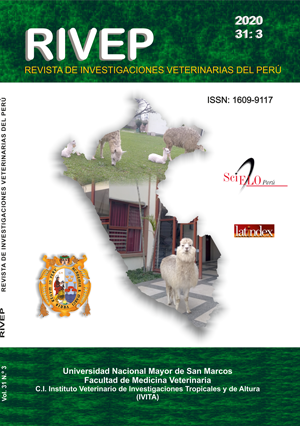Evaluation of a new protocol of superovulation in llamas: ovarian response, embryo recovery and post treatment effects
DOI:
https://doi.org/10.15381/rivep.v31i3.18731Keywords:
superovulation, eCG, embryos, llamaAbstract
The work aimed to evaluate the effect of two doses of eCG on the superovulatory response, embryonic recovery rate and reproductive disorders. Thirty-two clinically healthy adult llamas were used, divided into two groups: Group I (700 IU eCG; n = 15) and Group II (500 IU eCG; n = 21). The superovulation protocol included: day 1, induction of ovulation (GnRH); day 4, application of eCG according to the dose established for each group; day 8, application of luteolytic (PGF2α); day 11, ultrasound to verify the number of follicles and application of GnRH analog; days 11 and 12, natural mating to induce ovulation; day 19, uterine lavage and embryo recovery (it was considered as cervical torsion when the Foley catheter was difficult to pass to the uterus); day 26: ultrasound evaluation to determine the presence of reproductive disorders. The number of follicles per female for groups I and II was 4.9 and 3.7, respectively. The number of embryos collected was 1.6 and 2.6 per female in groups I and II, respectively, which would indicate the existence of possible ovulatory failure or early luteinization in group I. The frequency of persistent follicular cysts and corpus luteum was higher in Group I compared to Group II, while the frequency of metritis and cervical torsion were similar in both groups. It is concluded that the 500 IU dose of eCG allows obtaining a smaller number of follicles, but a greater number of embryos and a lower frequency of reproductive problems in the post-treatment.
Downloads
Downloads
Published
Issue
Section
License
Copyright (c) 2020 Joel I. Pacheco C., Víctor M. Vélez M., Wilber C.R. García V.

This work is licensed under a Creative Commons Attribution-NonCommercial-ShareAlike 4.0 International License.
AUTHORS RETAIN THEIR RIGHTS:
a. Authors retain their trade mark rights and patent, and also on any process or procedure described in the article.
b. Authors retain their right to share, copy, distribute, perform and publicly communicate their article (eg, to place their article in an institutional repository or publish it in a book), with an acknowledgment of its initial publication in the Revista de Investigaciones Veterinarias del Perú (RIVEP).
c. Authors retain theirs right to make a subsequent publication of their work, to use the article or any part thereof (eg a compilation of his papers, lecture notes, thesis, or a book), always indicating the source of publication (the originator of the work, journal, volume, number and date).










